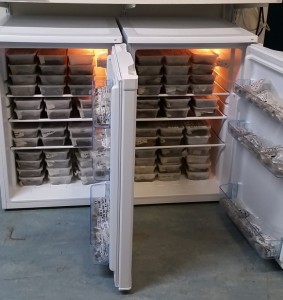What happens when 239 boxes of stained glass and lead are brought to conservators? We buy fridges!
15 March 2016
What happens when 239 boxes of stained glass and lead are brought to conservators? We buy fridges!

When a small car arrived outside Cardiff University’s John Percival building in mid-October, the conservators waiting outside to greet the representatives from the National Museum Ireland were not expecting to make scores of trips up to the 3rd floor laboratory. After utilizing the strength of several strong men, two carts, and an elevator, 223 boxes of glass and several large block lifted pieces were brought into what is going to be their new home for the duration of their treatment. One of the senior conservators who oversaw the unloading of our new objects, Phil Parkes, was wished luck and handed a list with all the box numbers and contents as we were left standing surrounded by piles of medieval window glass and lead.
Glass, by nature, is a very temperamental substance. It can become especially brittle if it has been left in a damp, cool environment, such as the ground, and is then suddenly left out to dry in the open air. Before even looking at how we would begin to examine, excavate, or clean these pieces, we needed to stabilize their environment so they would stay in the same condition they were found in.

When glass is buried, it usually corrodes, just like a piece of metal left outisde would. This will result in a loss of material and the water from the surrounding ground will fill in those gaps. If these pieces of glass were left to air dry, it is possible that they would lose the water that is helping to hold their form and crumble into dust. The onsite conservators and archaeologists that excavated these pieces knew this, so all the pieces came packed in the dirt they were found in and were sealed in clear Stewart boxes.

In the ground, the temperature has very little change and is usually cooler than the air temperature. In order to mimic that and make sure there are no wild swings in temperature that could cause expansion, cracking, or a change in relative humidity in the containers, the conservation department bought two brand new refrigerator units to house all the small finds.
All the boxes were checked and double checked and now sit in wait for the next stage—excavation and cleaning!
Meredith Sweeney
BSc Conservation Student
For more information on the process before the glass arrived at our lab click here.
Comments
3 comments
Comments are closed.
- March 2024 (1)
- December 2023 (1)
- November 2023 (2)
- March 2023 (2)
- January 2023 (6)
- November 2022 (1)
- October 2022 (1)
- June 2022 (6)
- January 2022 (8)
- March 2021 (2)
- January 2021 (3)
- June 2020 (1)
- May 2020 (1)
- April 2020 (1)
- March 2020 (4)
- February 2020 (3)
- January 2020 (5)
- November 2019 (1)
- October 2019 (1)
- June 2019 (1)
- April 2019 (2)
- March 2019 (1)
- January 2019 (1)
- August 2018 (2)
- July 2018 (5)
- June 2018 (2)
- May 2018 (3)
- March 2018 (1)
- February 2018 (3)
- January 2018 (1)
- December 2017 (1)
- October 2017 (4)
- September 2017 (1)
- August 2017 (2)
- July 2017 (1)
- June 2017 (3)
- May 2017 (1)
- March 2017 (2)
- February 2017 (1)
- January 2017 (5)
- December 2016 (2)
- November 2016 (2)
- June 2016 (1)
- March 2016 (1)
- December 2015 (1)
- July 2014 (1)
- February 2014 (1)
- January 2014 (4)
Any news on what is happening with these glass fragments now?
Jane, the conservation process is under way and there will be a post soon with an update! Thanks for following up with us 🙂